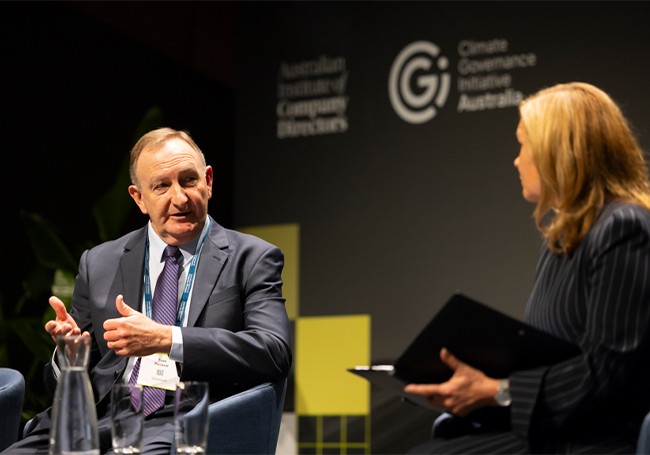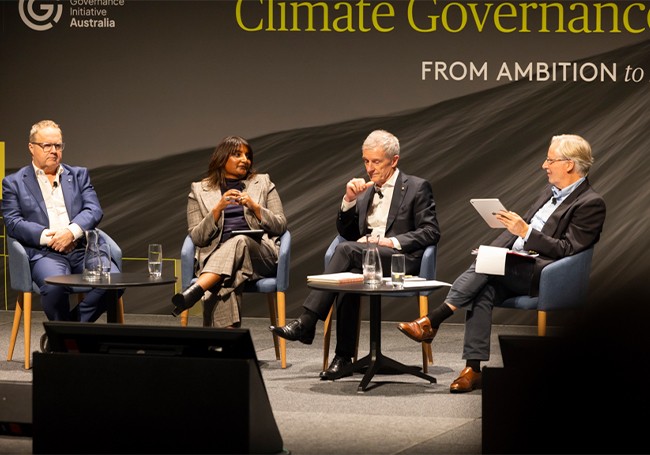The AICD’s fourth annual Climate Governance Forum, which was held in Melbourne on 8 August and attracted more than 1400 virtual and in-person attendees, examined regulation, compliance, climate conditions and how to move forward in the complex areas of reporting and transitioning.
Boards must embed climate strategy deeply into governance, culture and operations if they are to meet the urgent challenges of climate change, Tom Pockett MAICD, chair of IAG and Stockland, told the forum.
“Both the companies I chair can attest to the amount of management and board time devoted to understanding the risks and consequences of change in climate. There are very real impacts to our business, customers and broader value chains.”
The impacts of a warming planet are already weighing heavily on board agendas, Pockett told the forum. Since 2020, Australia has experienced 14 declared catastrophes, with $22.5 billion in insured losses over the past five years. “This represents a staggering 67 per cent increase compared to the previous five years,” he said.
The 2022 northern NSW and South East Queensland floods were the world’s largest insured catastrophe that year. Rising claims costs, driven by physical damage and global reinsurance pressures, threaten insurance affordability, especially for vulnerable communities. Last year, general insurers in Australia wrote 86 million policies and paid out around $50 billion in claims, Pockett said.
Culture and leadership
Climate governance begins with organisational culture, said Pockett. Both IAG and Stockland embed ESG responsibilities across all business units, supported by senior leadership. IAG has launched a Sustainability Faculty to build staff capability, while Stockland’s ESG strategy is anchored in decarbonisation, circularity, social impact and resilience.
Board oversight is critical, Pockett added.
At both companies, climate is a standing agenda item, with directors reviewing risks and opportunities, approving strategies, linking climate objectives to executive remuneration and overseeing disclosures aligned to the new mandatory reporting regime.
“Directors also engage in education sessions on emerging trends, given this is a rapidly evolving space and we know we don’t have all the answers,” he said.

Examples of tangible initiatives include Stockland’s use of engineered timber and lower-carbon concrete and renewable energy partnerships such as its Energy Bay rooftop solar program.
IAG has entered a six-year power purchase agreement with CleanPeak Energy, transitioned half its Australian fleet to hybrids or EVs and exceeded its target to help one million people reduce their natural hazard risks.
Transparency and collaboration
Pockett urged directors to approach disclosure with a “prospectus mindset” — qualifying all climate statements and securing legal assurance, given evolving standards and reliance on third-party data. He welcomed the consistency that mandatory reporting will bring, potentially accelerating the transition.
Climate adaptation and mitigation require a whole-of-system approach, engaging industry, government and communities, he said. Skills shortages, especially in trades, are already hindering disaster recovery, with climate pressures intersecting with other demands such as major infrastructure projects.
From stronger building codes to targeted tax reform, Pockett called for coordinated national action to safeguard economic and social stability. “I look forward to further discussion about creating a sustainable future and the important role played by boards. The implications for national economic and social confidence are significant if we don’t act together.”
Turning point for climate governance
AICD CEO and managing director Mark Rigotti told the forum that this year marks a turning point for climate governance. “Emissions targets are in place for 2030 and 2050, the government is in the process of setting an interim target for 2035 and we have now entered the first year of mandatory climate reporting.”
Nature governance reporting is now emerging as the next frontier. Nature-related risk might be harder to quantify than climate risk but is no less urgent, he said. “It’s the next major issue for boards to engage with — and the best boards are making sure they are taking an integrated approach — one that deals with climate and nature holistically, rather than as an afterthought or add-on.”
The federal government is looking to revive reforms to the Environment Protection and Biodiversity Conservation (EPBC) Act 1999 and is pledging to conserve 30 per cent of Australia’s landmass and marine territory by 2030.
Fit for purpose
Rigotti said these shifts reflect broader recognition — highlighted by former Treasury Secretary Dr Ken Henry AC in his recent National Press Club address — that Australian environmental laws are no longer fit for purpose.
The AICD is partnering with the University of Sydney on a dedicated Nature Governance Study, to better understand current director perspectives and emerging priorities in this space. Early insights show that directors agree boards have a critical role to play.
Three-quarters of directors surveyed see nature-related risks as important to their organisations, especially around business adaptation, pollution and land use change. Barriers include government policy and limited resourcing. One in three directors see lack of clarity on national environmental standards as a major obstacle.
“This highlights the pressing need for clearer regulatory guidance to support effective governance and long-term planning.”
Rigotti said climate change is not just a governance challenge but a leadership challenge. “It is worth reminding ourselves that the trajectory the world is on is perilous — and based on current global policy settings, we are likely to be living in a three degrees-plus world.”
Speed of engagement
Australia has been “lightning-fast” to embrace and act on climate governance, says Rebekah Cheney GAICD, climate governance lead at Deloitte Australia.
“It was just over two years ago that the International Sustainability Standards Board released its first sustainability standards and it has been less than a year since the legislation was passed, making Australia one of the first jurisdictions globally to introduce mandatory climate reporting.”

It wasn’t even a decade ago that climate was a very niche topic in the boardroom. “Yet, here we are now with a fully formed financial framework and all the opportunities and challenges that come with that,” said Cheney.
“What we know is that 67 per cent of listed entities — and in fact, 92 per cent of Group 1 listed entities — are already making some form of climate-related disclosures. And let’s just remind ourselves that for Group 1, or some of Group 1 will be signing those declarations in February (2026). So this is not far away.”
Boards and directors should call on that first reporting cohort for guidance.
“For those directors from those industries, do understand you have an obligation, because others will be looking to you to make sure your reporting is of a high standard”, said Rebecca McGrath AM FAICD, a director at Macquarie Group and UniSuper.
Australian Securities and Investments Commissioner Kate O’Rourke noted the regulator is focused on helping entities to comply. It has encouraged feedback AND published guidelines, including a new quarterly newsletter. “At ASIC, we have a very open door in terms of trying to support answering questions or narrowing uncertainty to the extent we can,” she said.
The earlier that organisations start, the better, said Timothy Stutt, a partner at Herbert Smith Freehills Kramer. “We’re encouraging clients to do dry runs, to cut and paste from existing reporting and see how it looks and where the gaps are and start writing it together as an exercise.”
What boards can do
Getting a transition plan in place, while not mandatory, “is definitely a great way of working through the realities of what we all need to address”, said Penny Bingham-Hall FAICD, a director at Fortescue Metals Group. “Whether we like it or not, there are a lot of risks that companies, particularly asset-rich companies, will be dealing with — the physical impacts of climate change.
“Also in Australia in particular, we are changing our whole energy grid, so how do we look to decarbonise? It's to have a credible plan. It really is having that discussion at the board level about what is your strategic pathway and then it's about the realities of a business case and what it's going to cost.”
Michael Ullmer AO FAICD, a director at Westpac and former Lendlease Corporation chair, described what he looks for in a transition plan. He said management needs to understand the existing carbon footprint and that education is “absolutely fundamental”. Lendlease ran a whole series of programs right across the organisation on the basics of climate change and how it impacted the organisation, including the board.
Spotting opportunities
The next step is for management to reflect on risk and opportunities — “and there are absolutely opportunities”, said Ullmer. “If you put in a bid as a developer to clients and you have a highly sustainable building, which is going to be more attractive to employees… then you’ll find that building is easier to lease... and easier to get capital investors.”
Further considerations include transition goals and timelines and how to build that into operating plans and budgets of each of the business units, then getting ownership by line management. It must also be embedded in the DNA of the whole company and linked to remuneration and culture.
“That’s what I’d expect to see as a banker. That’s what our bankers expect to see when they’re talking to their clients about whether they have a transition plan.”
Climate disclosure, rising risks and new opportunities
Mandatory climate disclosures are now a live reality for many Australian companies and momentum is accelerating, Climate Change Authority CEO Brad Archer told the forum. While unable to reveal the authority’s upcoming advice on Australia’s 2035 emissions target, Archer confirmed it would be “ambitious and responsible”.
The physical risks of climate change are intensifying faster than many expected, he warned. For directors, such shifts have profound implications for asset planning, insurance affordability and community resilience.
Adaptation will be as essential as mitigation, he added, referencing Productivity Commission recommendations for a national climate hazard database and a resilience star-rating system for housing. While commercial building ratings weren’t included, he suggests many boards will already be assessing vulnerabilities.
Despite sobering risk projections, Archer urged directors to focus on innovation and productivity gains from the transition. Advances in battery density, falling solar PV costs and under-used rooftop capacity on commercial buildings present opportunities to cut costs and capture value.
Begin with the science
The “lucky country” as Australia used to be called is probably the “unlucky country” now because of increases in extremes in climate — temperature, rainfall and coastal — which are all rapidly getting worse, said David Karoly, a member of the Climate Council and a Professor Emeritus at the University of Melbourne.
Australian government funding is not keeping pace with the need for increased research on how climate change is impacting different extreme weather events domestically, he said.
In a Q&A session with AICD chair Naomi Edwards FAICD, he added, “We know many of the impacts of climate change. We know how to fix those by communicating better with regional, local and wider communities to prepare in advance to manage the responses.”
However, federal plans to release a national climate risk assessment more than a year ago had been held up because it was too “scary”. “Because of ongoing emissions and lack of emission reductions at sufficient magnitude in Australia and around the world, we need to transition as rapidly as possible to renewable energy sources, not burning more coal and gas,” he said.
Zurich Australia and New Zealand chair Geoff Summerhayes GAICD said artificial intelligence (AI) would assist in streamlining data. “This feels very overwhelming at the moment to have collection of data, standardisation of data, assurance of that data,” he said. “But these are going to be business opportunities and platforms that will scale globally. These problems will be solved and AI will help.”
Change your mindset
“We just have to get across the fact that there are going to be worsening climate conditions. They’re to some extent predictably unpredictable. We’ve got to get used to being more resilient with our investments, too,” said Productivity Commissioner Barry Sterland PSM. Boards should examine how climate change will affect supply chains.
CEO of State Sport Centres and former president of Melbourne Football Club Kate Roffey AM GAICD said taking responsibility as individuals for basic things such as recycling properly is a first step.
Tom Campbell, a co-founder of Footy for Climate, said starting a working group can be really powerful. “Getting your colleagues together and talking about what’s important to you and coming up with practical solutions you can take to executive and board level has made a difference in my space.”
Tony Wood MAICD, energy program director at the Grattan Institute, said, “There’s no way to hide. Even if you don’t really like this topic, you’ll be affected by it in one way or another. The important issue for boards, particularly those for whom this is not right now at the top of their agenda, is to make sure it is.”
- Top image: From left AICD Head of Policy Christian Gergis GAICD; Penny Bingham Hall; Michael Ullmer, Zoe Whitton, MD of Pollination.
- Middle image: Tom Pockett with MC Ali Moore
- Bottom image: Barry Sterland, Dr Angeline Achariya FTSE GAICD, (Industry Innovation Science Australia), Tony Wood, and moderator Jeremy Cooper Strategic Adviser, ESG, MinterEllison
Practice resources — supporting good governance
AICD’s Policy team supports members with guidance on governance issues, including:
- Climate Change — Science Snapshot 2025: An Overview for Australian Directors
- Governing for Net Zero — The Board’s Role in Organisational Transition Planning
- A Director’s Guide to Mandatory Climate Reporting
- Opportunities in the Circular Economy
- Principles for Setting Climate Targets
Latest news
Already a member?
Login to view this content



.jpg)